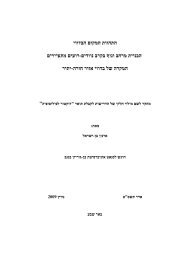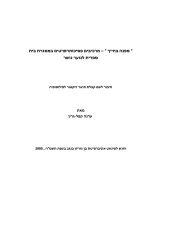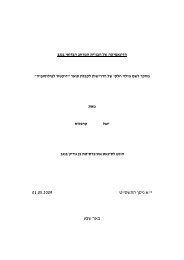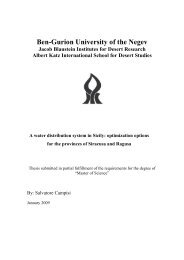CHARACTERIZATION OF DESERT DATE (Balanites aegyptiaca)
CHARACTERIZATION OF DESERT DATE (Balanites aegyptiaca)
CHARACTERIZATION OF DESERT DATE (Balanites aegyptiaca)
Create successful ePaper yourself
Turn your PDF publications into a flip-book with our unique Google optimized e-Paper software.
the various tissues of the B. <strong>aegyptiaca</strong> grown in Israel. For this purpose, liquid<br />
chromatography-mass spectrometry (LC-MS) and liquid chromatography-mass<br />
spectrometry /mass spectrometry (LC-MS n ) techniques were employed for the<br />
identification of the saponins in the fruit mesocarp, seed kernel, and root extracts of<br />
<strong>Balanites</strong>, and high field nuclear magnetic resonance (NMR) was used for structural<br />
elucidation of the major saponins in support of the LC-MS. The second aim of this study<br />
was to characterize the biological activities of the saponins from <strong>Balanites</strong> tissues.<br />
Various saponins and mostly saponin-rich extracts (SREs) were evaluated for the<br />
antifungal and larvicidal activity using some of the most prevalent phytofungi, and<br />
mosquito larvae. To increase the understanding of the interaction of saponin molecules<br />
with the plant membrane, another part of the study focused on the use of SREs as<br />
delivery adjuvants across isolated leaf cuticle membranes (CMs). A comparative study of<br />
saponin content in seed kernels and its correlation among five Israeli, as well as five<br />
international, provenances and the possibility of production of diosgenin (sapogenin) in<br />
callus culture in <strong>Balanites</strong> was also carried out.<br />
The LC-ESI-MS n characterization of the methanol extracts of fruit mesocarp of B.<br />
<strong>aegyptiaca</strong> grown in Israel found five major saponins with main one as1064 Da (ca. 42%<br />
of the total saponins). Other saponins found in the fruit mesocarp were: 1078, 1196,<br />
1210, and 1046 Da. The structures elucidated by 800 MHz NMR reveled that the main<br />
saponin (1064 Da) of fruit mesocarp was 26-(O-β-D-glucopyranosyl)-3β,22,26-<br />
trihydroxyfurost-5-ene3-O-β-D-glucopyranosyl-(1→4)-[α-L-rhamnopyranosyl-(1→2)]- β-D-glucopyranoside (1). Subsequently, the second (1210 Da) and third (1078 Da) major<br />
saponins in the fruit mesocarp were 26-(O-β-D-glucopyranosyl)-22-O-methylfurost-<br />
5ene.3β,26-diol 3-O-β-D-xylopyranosyl-(1→3)- β-D-glucopyranosyl-(1→4)-[α-L-<br />
rhamnopyranosyl-(1→2)]-β-D-glucopyranoside (2) and 26-(O-β-D-glucopyranosyl)-22-<br />
O-methylfurost-5ene.3β,26-diol 3-O-β-D- glucopyranosyl-(1→4)-[α-L-<br />
rhamnopyranosyl-(1→2)]-β-D-glucopyranoside (3), respectively. The LC-ESI-MS n<br />
analysis of the methanol extract of the kernel detected six saponins with main one being<br />
1210 Da (ca. 36% of total saponin). Similarly, nine saponins, with main one 1196 Da (ca.<br />
52.6% of the total saponins), were found in root extracts. In all these tissues, diosgenin<br />
was found only the sole aglycone for saponins. The chemical characterization experiment<br />
iii

















